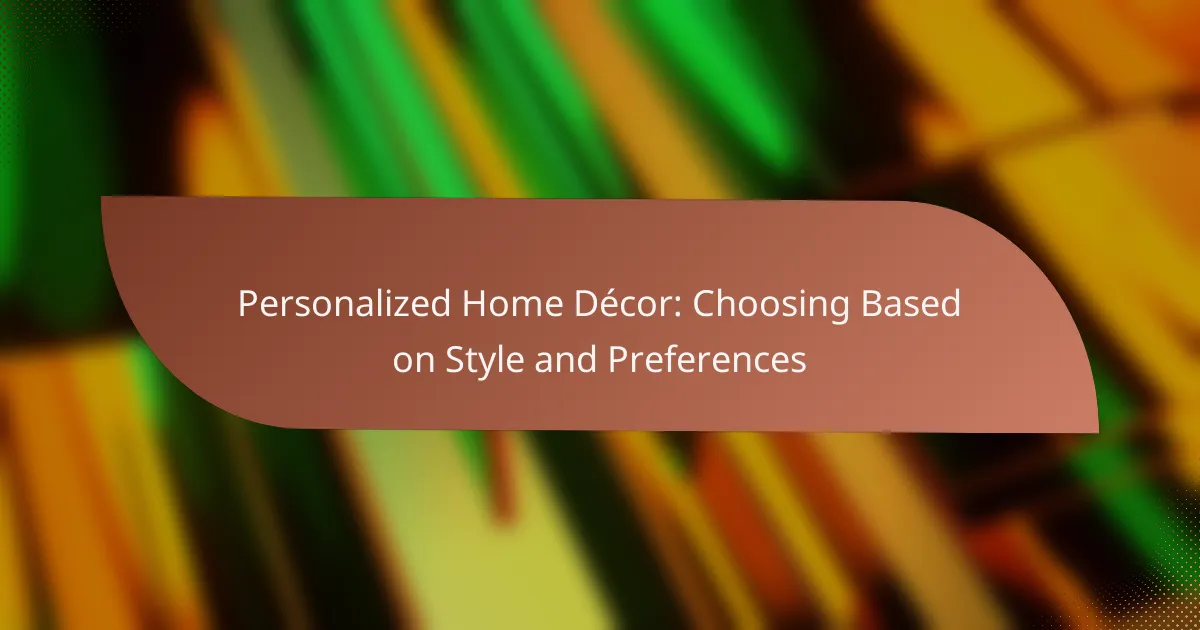Personalized home décor is a reflection of your unique style and preferences, allowing you to create a space that truly feels like home. By understanding various design elements and color schemes, you can curate an environment that showcases your personality and interests. Whether you lean towards modern minimalism or bohemian chic, the key is to harmonize different styles and textures to achieve a cohesive and inviting atmosphere.

How to choose personalized home décor based on style?
Choosing personalized home décor based on style involves understanding your aesthetic preferences and how they reflect your personality. This process requires careful consideration of design elements, color schemes, and personal interests to create a cohesive and inviting space.
Identify your design aesthetic
Start by exploring various design aesthetics such as modern, rustic, industrial, or bohemian. Look for inspiration in magazines, online platforms, or showrooms to determine what resonates with you. Consider creating a mood board to visualize your preferred styles.
Take note of key characteristics of each aesthetic, such as materials, shapes, and overall ambiance. This will help you narrow down your choices and focus on elements that truly reflect your taste.
Consider color palettes
Color plays a crucial role in setting the mood of your home. Identify a color palette that complements your chosen design aesthetic and evokes the desired emotions. Popular palettes include neutral tones, bold contrasts, or soft pastels.
When selecting colors, consider how they interact with natural light and existing furnishings. A good rule of thumb is to choose a primary color, a secondary color, and an accent color to create balance and visual interest.
Evaluate furniture styles
Furniture should align with your overall design aesthetic while also being functional. Assess different styles such as contemporary, vintage, or minimalist to find pieces that fit your vision. Prioritize comfort and practicality alongside style.
Measure your space to ensure that furniture dimensions are appropriate for your layout. Avoid overcrowding by leaving enough room for movement and flow, which enhances the overall comfort of your home.
Incorporate personal interests
Your home décor should reflect your personal interests and hobbies. Consider displaying items like artwork, books, or travel souvenirs that tell your story and add character to your space. These elements make your home uniquely yours.
Balance personal items with the overall design to maintain harmony. For instance, if you love nature, incorporate plants or nature-themed artwork to enhance your décor while staying true to your style.

What are the best home décor styles for personalization?
The best home décor styles for personalization cater to individual tastes and preferences, allowing homeowners to create spaces that reflect their unique identities. Key styles include modern minimalism, bohemian chic, traditional elegance, and industrial design, each offering distinct characteristics and opportunities for customization.
Modern minimalism
Modern minimalism emphasizes simplicity and functionality, focusing on clean lines, neutral colors, and uncluttered spaces. To personalize this style, choose a few statement pieces that resonate with your personality, such as a bold artwork or a unique light fixture.
Consider incorporating natural materials like wood or stone to add warmth without compromising the minimalist aesthetic. Avoid overcrowding the space; instead, opt for a few carefully selected items that enhance the overall design.
Bohemian chic
Bohemian chic is all about vibrant colors, eclectic patterns, and a relaxed vibe, making it a perfect choice for personalization. Layer different textiles, such as rugs, cushions, and throws, to create a cozy atmosphere that reflects your individual style.
Incorporate various cultural influences through art, plants, and handmade items. This style thrives on creativity, so don’t hesitate to mix and match elements that tell your story, whether it’s through travel souvenirs or family heirlooms.
Traditional elegance
Traditional elegance features classic furnishings, rich colors, and timeless patterns, allowing for a sophisticated yet personalized touch. To personalize this style, select antique or vintage pieces that resonate with your family history or personal experiences.
Incorporate luxurious fabrics like silk or velvet and consider using a muted color palette with occasional bold accents. Pay attention to details, such as ornate frames or decorative moldings, to enhance the traditional feel while still making it uniquely yours.
Industrial design
Industrial design combines raw materials and a utilitarian aesthetic, making it ideal for those who appreciate a modern yet rugged look. Personalize this style by incorporating reclaimed wood or metal elements that reflect your personal journey or interests.
Consider using open shelving to display unique collectibles or artwork that resonates with you. Balance the hard edges of industrial design with softer elements, such as plants or textiles, to create a more inviting atmosphere while maintaining the industrial charm.

How to mix and match home décor styles?
Mixing and matching home décor styles involves combining different design elements to create a cohesive look. Focus on harmonizing textures, colors, and focal points to achieve a balanced aesthetic that reflects your personal taste.
Layering textures
Layering textures adds depth and interest to your space. Consider combining materials like wood, metal, fabric, and glass to create a rich visual experience. For instance, pair a soft velvet sofa with a chunky knit throw and a sleek metal coffee table.
When layering, aim for a balance of rough and smooth textures. This contrast can enhance the overall appeal of your décor. Avoid overwhelming the space with too many competing textures; instead, stick to two or three key materials for a harmonious look.
Balancing colors
Balancing colors is crucial when mixing styles. Start with a neutral base, then introduce accent colors that complement each other. A good rule of thumb is the 60-30-10 rule: 60% of your space should be a dominant color, 30% a secondary color, and 10% an accent color.
Use a color wheel to find complementary shades. For example, if your primary color is blue, consider using warm tones like orange or yellow as accents. Be cautious not to use too many bold colors, as this can create visual chaos.
Creating focal points
Creating focal points helps draw attention and adds character to your space. Identify key areas in your room, such as a fireplace, a piece of artwork, or a statement piece of furniture, and design around them. This can guide the overall layout and style of your décor.
To enhance your focal points, use contrasting colors or textures to make them stand out. For example, if you have a vibrant painting, consider placing it against a neutral wall to emphasize its colors. Avoid cluttering the area around your focal point, as this can detract from its impact.

What are the top trends in personalized home décor?
Top trends in personalized home décor focus on sustainability, technology integration, and customization. These elements allow homeowners to create spaces that reflect their unique styles while being functional and environmentally conscious.
Sustainable materials
Sustainable materials are increasingly popular in personalized home décor, as they minimize environmental impact. Options like reclaimed wood, bamboo, and recycled metals not only reduce waste but also add character to your space.
When selecting sustainable materials, consider their durability and maintenance requirements. For example, bamboo is a strong choice for flooring, while recycled glass can be used for decorative elements. Look for certifications like FSC (Forest Stewardship Council) to ensure responsible sourcing.
Smart home integration
Smart home integration is a key trend that enhances convenience and efficiency in personalized décor. Devices such as smart thermostats, lighting, and security systems can be seamlessly incorporated into your design, allowing for remote control and automation.
To effectively integrate smart technology, choose devices that are compatible with each other and easy to use. For instance, a smart speaker can control lighting and music, creating an ambiance that suits your mood. Ensure that your Wi-Fi network can support multiple devices to avoid connectivity issues.
Customizable furniture
Customizable furniture allows homeowners to tailor pieces to their specific needs and preferences. Options range from modular sofas to adjustable shelving units, providing flexibility in design and function.
When selecting customizable furniture, consider your space and lifestyle. For example, a modular sofa can adapt to different room layouts, while a desk with adjustable height can accommodate various work styles. Look for brands that offer a range of fabrics and finishes to match your décor.

How to assess compatibility of décor items?
Assessing the compatibility of décor items involves evaluating how well different pieces work together in terms of size, materials, and functionality. This ensures a cohesive look and feel in your space, enhancing both aesthetics and usability.
Size and scale considerations
When choosing décor items, size and scale are crucial for maintaining balance in a room. Large furniture pieces can overwhelm a small space, while tiny accents may get lost in a vast area. Aim for a mix of sizes that complement each other, such as pairing a large sofa with smaller side tables.
A good rule of thumb is to ensure that the height of furniture is proportionate to the room’s dimensions. For instance, in a standard living room, a coffee table should typically be about one-third the height of the sofa. This creates a harmonious visual flow.
Material harmony
Material harmony refers to the way different textures and finishes interact with each other. Combining various materials can add depth, but too many conflicting textures can create visual chaos. For example, pairing a sleek metal lamp with a rustic wooden table can work well, but mixing too many shiny surfaces may feel overwhelming.
Consider the overall theme of your décor when selecting materials. If your style leans towards modern, opt for materials like glass and metal. For a more traditional look, wood and fabric may be more appropriate. Aim for a cohesive palette that enhances the overall aesthetic.
Functional compatibility
Functional compatibility ensures that your décor items not only look good together but also serve their intended purpose effectively. For instance, a decorative chair should be comfortable enough for sitting, while a coffee table should be at a suitable height for easy access to drinks and snacks.
Evaluate how each piece will be used in the space. If you have children or pets, prioritize durable materials that can withstand wear and tear. Additionally, consider the flow of movement in the room; ensure that furniture placement allows for easy navigation without obstruction.

What are the pricing factors for personalized home décor?
The pricing of personalized home décor is influenced by several key factors, including material quality, design complexity, and customization options. Understanding these elements can help you make informed decisions and manage your budget effectively.
Material quality
Material quality significantly affects the cost of personalized home décor. Higher-quality materials, such as solid wood or premium fabrics, generally lead to higher prices due to their durability and aesthetic appeal. In contrast, lower-quality options may be more affordable but could compromise longevity and overall satisfaction.
When selecting materials, consider the intended use and environment. For instance, outdoor décor items should be made from weather-resistant materials, which can increase costs. A good rule of thumb is to balance quality and budget, aiming for materials that offer the best value for your specific needs.
Common materials include wood, metal, glass, and textiles. Prices can vary widely; for example, custom wooden furniture might range from a few hundred to several thousand dollars, depending on the type of wood and craftsmanship involved. Always inquire about the source and sustainability of materials to ensure your purchase aligns with your values.
